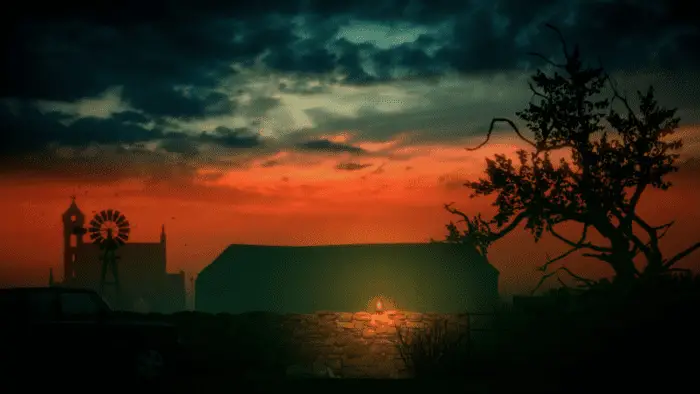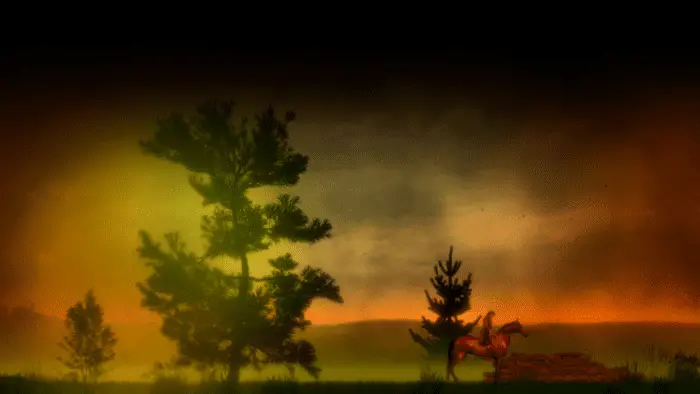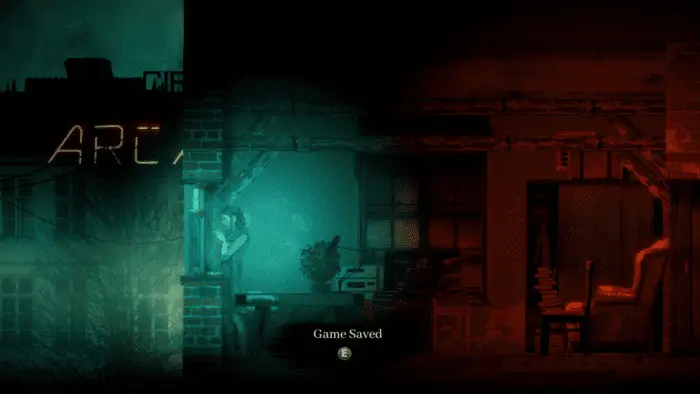Burnhouse Lane is a Beautiful Triumph for Harvester Games
Burnhouse Lane is the latest horror-adventure title from Harvester Games, a (mostly) one-man development team most well-known for creating the Devil Came Through Here trilogy. For those who don’t know, that trilogy focused on different troubled souls being visited by a being known as the Queen of Maggots. She would help them work through their problems in the most gruesome, roundabout ways possible. And while Burnhouse Lane is, as far as I can tell, disconnected from those stories, its DNA runs strong through this game. Burnhouse Lane very much feels like a culmination of everything that Harvester has put out so far, and it throws some new elements into the mix, too.
This apparently started off as a direct sequel to the first entry in the trilogy, The Cat Lady. And at a glance, there are a lot of borrowed elements from that title. TCL was about Susan Ashworth, a woman with profound depression, learning to live again while also fighting off Parasites that usually took the form of psychopathic murderers. Each chapter focused on a different antagonist, giving it a very episodic feel. Burnhouse Lane instead follows a woman named Angie who has recently been diagnosed with lung cancer after losing her husband to the same illness (his name is James, and this is far from the only nod to Silent Hill 2 Harvester snuck in). After attempting suicide, she is brought to the eponymous Burnhouse Lane, a strange, other worldly place for folks who have one foot in the cradle and the other in the grave. She is told there by a giant, malformed cat that there are several tasks she must complete to be rid of her illness. Each chapter focuses on one of those tasks, and along the way she meets new people while caring for an elderly man named George in the countryside.

While the setup is initially very similar to The Cat Lady, the specifics of the plot are very different. If The Cat Lady was about forgiving one’s self for their past, Burnhouse Lane is about living while you can and embracing life despite how unfair and cruel it can be. And make no mistake, the game does not sugarcoat Angie’s situation—there are numerous moments throughout of her pondering how unfair it is, and while it’s certainly quite dreary and depressing, the game’s final chapter does a lot to pay that sorrow off. Despite the down-beat, bittersweet ending I got on my playthrough, I didn’t feel like it was too miserable or that it wallowed too much in Angie’s plight. In fact, there were some scenes later on that felt wonderfully cathartic despite the doom hanging over everything. It also does a fantastic job of implementing its themes into gameplay—the most telling example of this is the fact that you save by smoking. Saving is important in almost any game, and it makes a powerful statement about addiction that it makes Angie have a smoke whenever you want to save.
It helps that the supporting cast is well-drawn and memorable, too. For instance, Angie runs into Ciaran early on, the somewhat slow-witted but well-meaning groundskeeper for George’s farm. There are others that enter the mix that venture into spoiler territory, but on the whole, the game does a great job and making you understand who these people are—even the villains. Since each chapter focuses on a different conflict or task, the villains aren’t given a whole lot of time to develop, but Harvester still manages to flesh them out during their short screen time. For instance, the third chapter concerns a mythic figure in the woods named Walter Green. The mysterious and gruesome nature of the murders he commits has led to him gaining a bizarre cult following, so a Walter Green enthusiast that’s exploring the woods helpfully explains what’s going on in a way that feels natural.
Your relationship with the cast is important in the game’s ultimate outcome, too. You are given multiple dialogue options for conversations, and sometimes you’re given a choice on how to react to different characters’ actions. I personally tried being friendly with everyone—to me, it didn’t make sense that Angie would be a cold, mean person. That being said, there’s a character that shows their true colors later on that I didn’t forgive, and the result was a down-beat, haunting ending to their part of the tale. It’s usually not too tough to figure out which reaction will do what, which is a tough balance to strike with cryptic systems like this. Harvester has done a good job in giving hints to the player without explicitly telling them what the outcome of a given choice or action will be. It gives the first playthrough an oddly personal touch, like I had become Angie and decided how to behave. These elements were prevalent in the Devil Came Through Here trilogy, too, but I’d say they’re at their best in Burnhouse Lane.
Gameplay, meanwhile, is simple and very similar to many other adventure titles. You have an inventory you can carry items around with, and you use those items to interact with the environment in a variety of ways. One of Harvester’s greatest strengths has always been puzzle design. Outside of a few instances in past titles, there’s usually a really grounded logic that’s not too tough to figure out, but still makes the player feel clever when they find the solution. This largely holds true for Burnhouse Lane, but I will say that there were a few instances where the solution to a puzzle seemed really obtuse. A couple of times I smacked myself for not realizing it sooner, but other times I had to shake my head. These are few and far between, and mostly prevalent when you’re trying to get the best ending, but sometimes the ambition of the setting gets in the way of logic.
Brand new to this game is full-on combat. When I first heard that it would include the ability to fight back against monsters, I thought it would stray away from the adventure game style of Harvester’s previous works and become a full-on survival horror experience. I thought you would be doing things like dodging monsters, exploring rooms, conserving ammunition, et cetera, et cetera. In reality, combat is fairly sparse. There is typically only one or two instances of it per chapter, and it’s pretty much as simple as raising your gun and firing a few times (or timing weapon swings properly, as they have very deliberate animations). I never found myself without enough ammo for the various situations the game puts you in, so there wasn’t a whole lot of stress in managing your supplies.

I’m fairly mixed on how combat is implemented. On one hand, it shakes things up in a gory, violent way, but on the other, it’s so simple that I wonder if the game would have been improved by removing it entirely. Angie doesn’t have a health bar or anything like that. Instead it’s game over if you’re grabbed by a monster, and you’re sent to the last checkpoint. This trial-and-error method of getting through life or death situations really grated on me when they were first introduced and it never really went away for the game’s run time. Being sent back to a checkpoint just feels like wasted time. There are a couple of instances later on where it’s used cleverly (such as a boss fight in the final chapter) but on the whole I don’t know if I want it to return if Harvester chooses to make another game.
The final new element to the game is Cat Powers. Early on, Angie is given the ability to make people tell the truth regardless of whether they want to or not, and eventually she can control cats (weird that there were two indie titles in 2022 that let players control felines), and reanimate corpses. Sadly, these powers are all used at fixed intervals. I initially thought you would be able to get creative, but you can only use them in very specific instances. Reanimating corpses, for example, is used in one chapter and that’s it. You can control a cat more frequently, and these are used to solve platforming puzzles that I found clunky and annoying. The physics for the cat feels imprecise, leading to a lot of falls and do overs that, like the combat, largely felt like it was wasting my time. Don’t get me wrong, I love that you can play as a cat, but I’d like to see it with maybe less clunkiness next time.
Special mention must be made of this game’s aesthetics. The Devil Came Through Here trilogy had exceptional visual design, with extremely detailed environments and strong use of color. Burnhouse Lane is probably the most out and out beautiful title that Harvester has made yet, with absolutely stunning lighting and fantastic attention to the environments that make them feel lived in and real. In a clever touch, smoking at a save point also doubles as a sort of vibe check. The camera pans out while Angie smokes, and the player determines how long she stays like that before moving on. These quiet moments really let you soak in the atmosphere, which is both horrifying yet oddly beautiful in a way I struggle to describe. It is similar to how Hollow Knight let players take a break by sitting at benches. It’s a nice way to break up the pace and not let the player get lost in the game’s darkness, and I hope more games use similar artistic flourishes.

Burnhouse Lane is similar to Harvester’s previous works, and in particular borrows more than a little bit from The Cat Lady in its structure, but it also tells a powerful story about coming to terms with how cruel life can be. It’s marketed as a horror title, but like The Cat Lady and Lorelai, I found myself most invested in the way it portrays its cast and how it tackles universal themes of fear and despair. Rather than saying we simply shouldn’t be afraid, it tells us to experience it along with all the other emotions life brings. It’s a really special piece of work from a creative mind, one that understands just how vital it is in horror to make the player feel something. There are certainly a few missteps along the way, but they’re not enough to detract from the potent, bittersweet story Burnhouse Lane tells.
Burnhouse Lane is now available on Steam.











